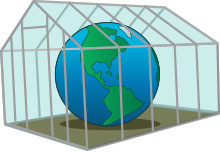Cool our planet

source: http://www.haus-und-wohnen.ch
Similar as a parasol aerosol particles can
reflect parts of the visible light back to the sun and therefore reduce the
amount of solar energy reaching the surface of our planet.
|
Warm our planet

source: http://climatekids.nasa.gov/
Similar as greenhouse gases, some aerosol particles can absorb and emit thermal radiation and thus enhance the
natural greenhouse effect.
|
Interact with clouds

Aerosol particles can serve as nuclei to facilitate the condensation of
water vapour from the air and have a large effect on the properties of
clouds. For more detailed information see below.
The  EU project BACCHUS analyses the interactions between aerosol
particles and clouds. EU project BACCHUS analyses the interactions between aerosol
particles and clouds.
|
Impact ozone

Aerosol particles can provide surfaces for certain chemical reactions
that can only occur where gases are in contact with liquids or particles
and play a major role in atmospheric ozone chemistry.
The  EU project StratoClim analyses the role of aerosol particles at
higher atmospheric levels in climate. EU project StratoClim analyses the role of aerosol particles at
higher atmospheric levels in climate.
|
Harm human health

Aerosol particles are an important factor in air quality and have an
adverse effect on human health.
The  EU project DACCIWA analyses the impact of aerosol particles on air
quality and climate in West Africa. EU project DACCIWA analyses the impact of aerosol particles on air
quality and climate in West Africa.
|




